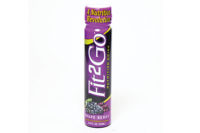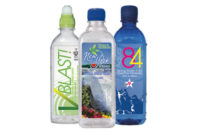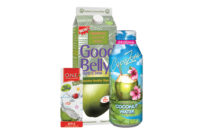
While the iconic Golden Arches signal convenience to many consumers, McDonald’s USA proved two years ago that it could be more than quick and value-priced with the introduction of its Premium Roast Coffee and other premium food offerings. Now that the coffee has kicked in, the Oak Brook, Ill.-based restaurant chain is using its beverage portfolio to make it more contemporary and relevant — and plans on giving other beverage-focused retailers a run for their money.
It all begins with the customers.
“Customers’ beverage tastes have evolved over the last few years. It’s clear to us, with those change in tastes, there’s an opportunity for us to meet more of their needs,” says the man behind the move, John Betts. As McDonald’s vice president, national beverage strategy, Betts led the team that currently is rolling out the beverage business. He was recently promoted to president of McDonald’s Restaurants of Canada Ltd.
Don Thompson, president of McDonald’s USA, emphasized beverages changing role with the company when he commented in an analyst meeting late last year: “We want to move from beverages as an accompaniment to being a beverage destination.”
That’s a promising statement for beverages from the world’s largest restaurant chain. McDonald’s operates more than 31,000 restaurants in 118 countries, with almost 14,000 U.S. restaurants. Serving nearly 56 million customers every day, McDonald’s revenues reached a record high of $22.8 billion on global comparable sales in 2007.
In its fourth-quarter reporting, Jim Skinner, McDonald’s Corp.’s chief executive officer, touted McDonald’s beverage performance. “For the quarter, the U.S. business generated solid comparable sales growth of 3.3 percent and increased operating income by 6 percent by staying in tune with growing consumer demand around breakfast, beverages and everyday value,” he said.
With the challenges of rising food costs and a slowing economy, a strong beverage menu, including the introduction of specialty coffee drinks and the testing of bottled beverages, new fountain options and smoothies, offers the restaurant giant an opportunity to increase revenue.
To go along with the new beverage lineup, the company also is revamping its look. McDonald’s restaurants are being redesigned to become more contemporary, with some locations featuring leather chairs, high-top tables, flat-screen TVs and even fireplaces. More than 9,000 of its restaurants offer a wireless connection for customer convenience. And being convenience driven, McDonald’s restaurants are opening earlier — nearly 80 percent are open at 5 a.m. — and staying open later or not closing at all.
Premium to specialty
McDonald’s beverage expansion began in 2006 with the launch of its Premium Roast drip coffee. As with other new products debuting on the menu at the time, such as Premium Chicken Sandwiches and the Asian Salad, Premium Roast Coffee reflected the consumer trend toward premium products.
“The intent was to really contemporize and take our blend to the next level based on consumers’ changing taste preferences and desire for more sophisticated coffee drinks,” says Danielle Paris, menu management – food innovation and development for McDonald’s USA. “Once we did that, it really helped us establish credibility in the coffee industry.”
Premium Roast Coffee sales increased 30 percent during 2007, reported Jan Fields, McDonald’s USA’s executive vice president and chief operating officer, during a Webinar late last year.
The idea for Premium Roast Coffee began in McDonald’s Michigan restaurants. Betts, who has 38 years of McDonald’s experience and has been a McDonald’s general manager in three U.S. regions, served four years as the Michigan region’s general manager. It was while he was in Michigan that much of the work with Premium Roast Coffee began.
“We recognized that we had a business opportunity in the area of breakfast,” Betts says. “In the morning, coffee is the primary motivator for customers. The coffee offering we had was good, but it wasn’t resonating.”
The richer, bolder, robust Premium Roast Coffee really struck home with customers, Betts says. “We enjoyed a great deal of feedback from them and certainly enjoyed the changes in our business around the coffee,” he says. “We discovered that they wanted even more.”
The next step for McDonald’s was making its premium coffee offering more convenient for customers. “Most of our coffee goes through the Drive-Thru, and listening to customers, something that was important to them was saving a little time,” Betts explains.
With McDonald’s serving 26 million U.S. customers a day and two-thirds of the patrons going through the Drive-Thru, McDonald’s instituted “coffee customization.” Employees add sugar and cream to the coffee to the customer’s specification, and the customer doesn’t have to stop, pull over and put the cream and sugar in the cup and stir.
Last year, McDonald’s continued its coffee development by adding Iced Coffee options in Plain, Hazelnut and Vanilla flavors. Gathering feedback from customers and owner operators, McDonald’s discovered that customers thought the coffee changes were terrific, but they wanted to know what’s next, Betts says.
“We started with tests in some markets to offer the espresso-based coffees to see what kind of reaction the customers would have,” he says. “Coming off our successful launch of the Premium Roast, they took to it very quickly.”
McDonald's coffee specialty
The quick-service restaurant chain continued its big plans for beverages with the launch of McCafé Specialty Coffee drinks. McDonald’s began test marketing traditional favorites — lattes, cappuccinos and mochas — in areas such as Michigan in 2007. This year and next will be met by an aggressive rollout of the McCafé Specialty Coffee drinks, Betts says.
The specialty coffee menu includes Regular, Vanilla and Caramel Lattes and Cappuccinos, Mocha, Iced Vanilla Latte and Iced Mocha. Customers will have the choice of whole and non-fat milk for their specialty coffee drinks, and McDonald’s also offers a sugar-free vanilla syrup.
“We want to stay relevant and reached out to customers for them to tell us what their needs are,” Paris says. “The milk choice and also having a sugar-free syrup available are two things that we’ve done to address customers’ needs.”
McDonald’s worked with a team of experts to develop the flavor profile for its Premium Roast coffee, and the same extensive research was conducted in developing the specialty coffee offerings. While the Premium Roast blend is more of a medium roast coffee, McCafé Specialty Coffee drinks’ espresso blend is a darker roast, Paris says. The espresso blend is comprised of beans from Central and South America and the mountainous regions of Indonesia.
In order to provide authentic espresso for customers, McDonald’s needed the right technology to deliver premium coffee at a convenient speed, Paris says. The specialty coffee drinks are made with a one-step machine that grinds the espresso beans, brews the espresso and steams the milk, all in one process. The three flavors McDonald’s offers — Vanilla, Caramel and Mocha — are added by the barista.
“We have selected a piece of equipment which is very sophisticated, but it’s also very flexible,” Paris says. “It will allow us to make a number of different beverages at a speed which is really required to make our speed of service, but it is done without sacrificing quality. The most important thing is we want to be able to provide our customers with authentic specialty coffee beverages, very high quality at the convenience of McDonald’s.”
Additionally, McDonald’s is taking an in-depth approach to training employees on how to use the machine and about the specialty coffees, Betts says.
“This isn’t about just pouring coffee into a cup and putting a lid on it,” he says. “This is about them understanding a whole new business, a whole new culture, a whole new way of providing great-tasting coffee and more of a beverage experience in our restaurants than in the past.”
Employee instruction begins with restaurant managers’ education in training restaurants. Managers learn about the origin of coffee and coffee culture in the classroom, and also spend an extensive amount of time on the floor learning how to make the products. At the restaurant, managers take their knowledge back and the crew is provided with training materials to watch. A training card is also kept above the machine.
“The most important thing that we emphasize with the crew is the freshness of the coffee, maintaining that high quality at all times,” Paris says. “We’ve also developed a very extensive training program where we’re educating our crew on not only how to operate equipment, but the important sensory attributes of the drink … There are visual characteristics. There are taste characteristics, and that’s all a part of our comprehensive training program.”
The specialty coffee equipment also is equipped to make Premium Hot Chocolate, so the Hot Chocolate machine will be removed with the installation of the new equipment. And if McDonald’s decides to expand the line, the company could stay with the same technology, which is flexible enough to meet future needs as well, Paris says.
“It will allow us to build on the portfolio of flavored specialty drinks, different flavors or different toppings,” she says.
Beverage-ready
The McCafé Specialty Coffee rollout is not as easy as it sounds, even with easy-to-use equipment and customer appeal. Restaurants have been redesigned or will have to be updated to include a coffee bar, which is a substantial investment for the new beverage launches.
The coffee bar normally is positioned to the left of the counter near the Drive-Thru window for convenience and visible so customers can see their specialty coffee drinks being made. Footprints may differ because of lobby floor plans, but the specialty coffee-making equipment, training of the crew and communication to customers will be the same, Betts says. The new coffee bar area also includes space for the new smoothie drinks and frappe equipment McDonald’s currently is testing.
McDonald’s coffee expansion could require an investment up to $100,000 per restaurant, which includes the new equipment and expenses for remodeling. The company will financially assist franchisees by paying up to 40 percent of the beverage build-out.
“The business case was built understanding the economics, and we’re very comfortable with the opportunity that we have to get a great return on our investment and to be able to enter this business profitable from the start,” says Don Armstrong, who is chairman of McDonald USA’s National Leadership Council (NLC). The NLC is a group of 37 McDonald’s franchisees, elected by peers, to represent more than 2,400 franchisees, who independently own and operate more than 11,000 McDonald’s restaurants in the United States.
The potential profits for the restaurant owners are encouraging. By 2009, McDonald’s expects its combined beverage business to add $1 billion to the company’s sales, once fully executed.
The popularity of specialty coffee drinks and the opportunity for a return on the beverage investment has restaurant owners excited about the beverage expansion, Armstrong says.
“We’ve had, at a time, upwards of 400 operators who have been a part of helping to develop it,” the chairman says. “It really is something that has not been done in a casual way … We believe that we have developed the right program for our customers and that we have the right program for the economics of this and that we have the right program to be able to deliver on this operationally within our restaurants.”
Getting the word out
Building the new coffee bars isn’t enough though. Education about the new specialty coffee drinks begins with owners, managers and employees. Sampling of the new drinks also will play a key role in customer education.
“Generating trial, getting product in the hand of the customer is a very intricate part of helping them understand what the offerings are,” says Donna Kemp, a McDonald’s operations consultant whose supervision includes a Wheaton, Ill.-restaurant with the coffee program.
“Sampling done right makes a big difference,” she continues. “We found that on the busiest day of the week, Friday, sampling throughout the entire day really captures new customers that have not tried the product.”
McDonald’s is currently advertising in markets where a significant number of the restaurants have the coffee program, such as Michigan. The marketing includes TV commercials, billboards and sampling at college events, because “many of the specialty coffee drinks appeal to young adults,” Betts says.
But the new specialty coffees aren’t targeting one specific consumer, he adds. While the drip coffee tends to lean toward older consumers and males, the specialty coffee drinks attract more females. Iced drinks overall skew to younger customers. Currently, McDonald’s top-selling specialty coffee drink is the Iced Mocha.
“When we finish our whole effort, we are going to be offering smoothies, which plays to moms and younger kids because of the fruit-based nature of it and their nutritional benefits,” Betts says. “The frappes, which are coffee based, very rich indulgence, almost like a dessert, skew younger. So we’re across all different segments and even across the different ethnic groups. Everybody is going to be able to find two or three things out of our new beverage offerings that are going to resonate.”
Since McDonald’s started its beverage expansion with the specialty coffee drinks, the restaurants already are seeing additional traffic at breakfast time. But the increased traffic is not limited to breakfast time, Betts says.
In addition to the new flavors’ appeal and McDonald’s convenience, the new beverages are priced competitively. Depending on the market, the specialty coffee drinks are 30 cents to 80 cents less expensive than competitors’ offerings.
“They are a great value the way we have them positioned today,” Betts says. “They are a little bit higher priced than some of our other beverages, but they are certainly very competitive.”
Bottled beverages and beyond
McDonald’s coffee program marks the beginning of its beverage expansion. Still in development, Real Fruit Smoothies are in the early stages of testing in several locations. When the restaurants remodel for the coffee program, a spot will be left for the smoothie equipment to be dropped in, so the restaurants will be prepared for the rollout.
McDonald’s currently has low-fat yogurt and non-dairy smoothie options available, and it is testing varieties such as Wild Berry, Tropical Fruit and Strawberry Banana. Available in 12-ounce, 16-ounce and 20-ounce sizes, the smoothies currently offer up to two servings of fruit, Betts says.
Continuing its quest to provide beverages that resonate with customers, McDonald’s is also in the final testing stages for its new bottled beverage offerings.
“It all starts with customers,” Betts says. “To satisfy our customers’ requests for even more beverage options, we’re working with our suppliers to introduce a selection of bottled beverages as well as expand the selection of the fountain beverages in all of our U.S. restaurants. It’s about providing customers with a wide variety of great-tasting beverages at the speed, value and convenience our customers expect whenever they visit our restaurants.”
In the final states of negotiation with suppliers, Betts says McDonald’s restaurants have been testing bottled sports drinks, teas, water and energy drinks.
“It’s not about having 100 different bottles,” he says. “It’s about having ones that motivate consumers that we don’t offer today that fit a lifestyle need or taste that we currently don’t have.”
McDonald’s also does not plan to be a bottled beverage location like a convenience store, Betts says. The bottled beverages are being tested in coolers behind the counter, similar to where the orange juice and milk cooler is located now. A cooler also will be positioned near the Drive-Thru.
Along with testing bottled beverage offerings, McDonald’s is testing new selections in its fountain line. “They have to complement each other,” Betts says.
“It’s important for us, with everything that we’re doing as we bring in these different offerings, that we’re able to not have the experience consumers are used to from friendliness, accuracy and speed impacted,” he says.


